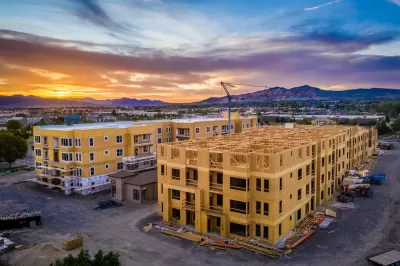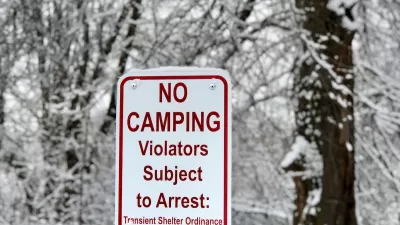How U.S. cities are seeking to diversify their funding sources for housing assistance programs and eliminate barriers to housing construction.

In an article for Smart Cities Dive, Kalena Thomhave outlines emerging trends in how cities approach reducing homelessness and alleviating the housing crisis, which continues to impact most American cities. “Just 34 affordable rentals are available for every 100 renters with extremely low income, according to the National Low Income Housing Coalition.”
As Thomhave notes, some cities are using their local power to reduce zoning restrictions on multifamily housing, enact tenant protection and rent stabilization laws, and outlaw discrimination against housing voucher recipients. “Alongside plans for the construction of permanent housing, cities are also building interim housing: safe, temporary housing for people experiencing homelessness.”
Cities are also looking for ways to reduce dependence on federal housing assistance programs. One such revenue source, the so-called “mansion tax” on transfers of high-value properties, was passed by over a dozen localities since 2018 and could become a significant source of new revenue for affordable housing programs.
Taking a different approach, some cities are taking more punitive measures against unhoused people after a Supreme Court ruling, Grants Pass v. Johnson, paved the way for the criminalization of homelessness.
FULL STORY: How cities could tackle homelessness in 2025

Alabama: Trump Terminates Settlements for Black Communities Harmed By Raw Sewage
Trump deemed the landmark civil rights agreement “illegal DEI and environmental justice policy.”

Planetizen Federal Action Tracker
A weekly monitor of how Trump’s orders and actions are impacting planners and planning in America.

The 120 Year Old Tiny Home Villages That Sheltered San Francisco’s Earthquake Refugees
More than a century ago, San Francisco mobilized to house thousands of residents displaced by the 1906 earthquake. Could their strategy offer a model for the present?

In Both Crashes and Crime, Public Transportation is Far Safer than Driving
Contrary to popular assumptions, public transportation has far lower crash and crime rates than automobile travel. For safer communities, improve and encourage transit travel.

Report: Zoning Reforms Should Complement Nashville’s Ambitious Transit Plan
Without reform, restrictive zoning codes will limit the impact of the city’s planned transit expansion and could exclude some of the residents who depend on transit the most.

Judge Orders Release of Frozen IRA, IIJA Funding
The decision is a victory for environmental groups who charged that freezing funds for critical infrastructure and disaster response programs caused “real and irreparable harm” to communities.
Urban Design for Planners 1: Software Tools
This six-course series explores essential urban design concepts using open source software and equips planners with the tools they need to participate fully in the urban design process.
Planning for Universal Design
Learn the tools for implementing Universal Design in planning regulations.
Clanton & Associates, Inc.
Jessamine County Fiscal Court
Institute for Housing and Urban Development Studies (IHS)
City of Grandview
Harvard GSD Executive Education
Toledo-Lucas County Plan Commissions
Salt Lake City
NYU Wagner Graduate School of Public Service





























